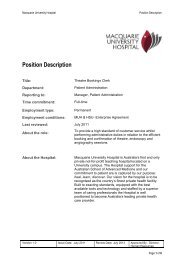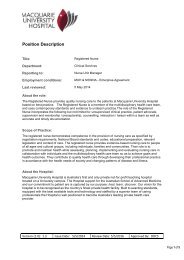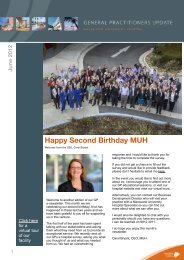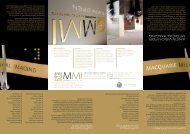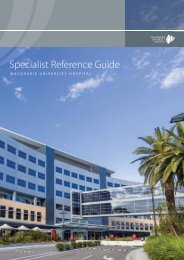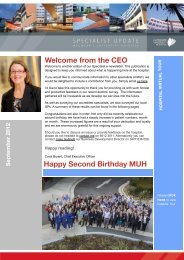Plenary Oral Presentations - Macquarie University Hospital
Plenary Oral Presentations - Macquarie University Hospital
Plenary Oral Presentations - Macquarie University Hospital
You also want an ePaper? Increase the reach of your titles
YUMPU automatically turns print PDFs into web optimized ePapers that Google loves.
16 th International Meeting of the Leksell Gamma Knife ® SocietyMarch 2012, Sydney, AustraliaVA-116Our treatment strategy of cerebralarteriovenous malformation: safer radiosurgerycombined endovascular surgery1Osamu Nagano, 2 Toru Serizawa, 3 Shushi Kominami, 4 Yoshinori Higuchi, 1 Shinji Matsuda,1Kyoko Aoyagi, 5 Toshio Machida, 3 Shiro Kobayashi, 5 Junichi Ono, 4 Naokatsu Saeki1Gamma Knife House, Chiba Cardiovascular Center, Ichihara, Japan2Tokyo Gamma Unit Center, Tsukiji Neurological Clinic, Tokyo, Japan3Department of Neurosurgery, Chiba-Hokuso <strong>Hospital</strong>, Nippon Medical School, Chiba,4Department of Neurological Surgery, Chiba <strong>University</strong>, Chiba, Japan5Department of Neurosurgery, Chiba Cardiovascular Center, Ichihara, JapanObjective: We analyzed to define the benefits and risks of gamma knife radiosurgery (GKS) forarteriovenous malformation (AVMs) patients who underwent prior embolization.Methods: Between 1999 and 2011, we performed GKS on 300 patients with cerebral AVMs (nidusvolume less than 10.0 cm3); 100 patients underwent embolization prior to GKS (group A), 200patients without embolization (group B). We evaluated obliteration rate, latency interval hemorrhageand symptomatic delayed radiation injury (DRI) compared between 2 groups using Kaplan-Meiermethod. Our treatment policy is that embolization prior to GKS is necessary for large volume AVM(more than 10.0 cm3), high-flow AVM and intranidul aneurysm in order to reduce the risk of AVMbleeding during latency period and DRI.Results: In this study, 126 patients (63%) had at least one prior hemorrhage in group A and 63patients (63%) included in group B. The median target volume was 3.1 cm3 (range 0.05 to 9.2) ingroup A and 1.7 cm3 (range 0.08 to 9.6) in group B. The median peripheral dose was 19 Gy in groupA and 20 Gy in group B. The actuarial obliteration rates on angiography at 4 years were 90% in groupA and 87% in group B (p=0.37). Latency interval hemorrhage developed in 1 case at group A (cumulativerisk was 1.1% at 10 years) and 8 cases at group B (6.9% at 10 years) (p=0.24). Symptomatic DRIwas observed 2 cases in group A (cumulative risk was 7.0% at 10 years), 7 cases in group B (4.2% at10 years) (p=0.89).Conclusions: Our study demonstrated that prior embolization did not change the obliteration ratewhile it may reduce the risk of AVM bleeding and DRI after GKS.76



